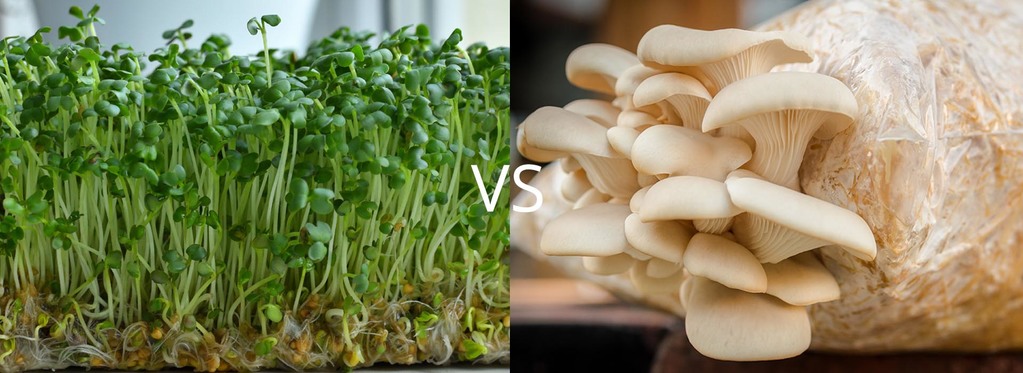Mushrooms and microgreens are both great crops that you should consider growing. But how do you know which is a better fit for you?
In this article, I’ll explain what growing both microgreens and mushrooms takes, and what the process for growing each looks like. I’ll explain the similarities between growing these two crops, as well as some of the differences. I’ll also explain why I think it makes perfect sense to start growing both of these crops together.
Mushrooms vs. Microgreens
Interest in growing both mushrooms and microgreens is booming.
They’re both high value crops that are relatively easy to get started with. They also don’t need a lot of space to produce a profitable crop.
Taking all of their advantages into account, both mushrooms and microgreens are a very attractive option for new growers.
Growing Mushrooms – What Does It Look Like?

The process of growing mushrooms starts with inoculation on day 1. This means introducing spores or an existing culture into your growing medium of choice.
The growing medium will depend on the type of mushroom that you’re trying to grow, but may include things like straw, hay, coffee grounds, or compost.
From day 1 to 21 of the process, mushrooms go through an incubation period.
During this time, the mycelium (essentially the root system and main structure of the mushroom) is allowed to fully colonize the growing medium.
This step is necessary to give the mycelium a chance to get well established and prevent any issues with contamination from other types of fungi or mold.
From around day 21 to day 30 of the process, mushrooms are placed in special conditions to trigger them to begin fruiting. Over about a week, the mushrooms will grow from tiny pins to full size.
Around day 30, mushrooms are harvested and prepared for market. A second crop (also called a flush) will grow once the first round of mushrooms are harvested, and the next batch will be ready in another 1 or 2 weeks.
After two crops, the substrate is taken out and composted, and the steps are repeated over again.
Of course, depending on the type of mushroom you’re growing, some of these steps can be shorter or longer. The above information assumes you’re farming a fast-growing species like oyster mushrooms.
Learn deeper about crops farming in my guide of How To Set Up A Low Tech Mushroom Farm here.
The Parts of A Mushroom Growing Operation
These are the different areas you’ll need for your mushroom growing operation.
-
A mixing and inoculation space. This is where your growing medium will be inoculated and prepared for inoculation. A full clean room with negative air pressure is not usually necessary. But this area should be kept as clean and sterile as practically possible. There is the most that can go wrong at this part of the mushroom growing process, and contamination of your grow bags can ruin an entire batch of mushroom crops.
-
An incubation room. Mushrooms will sit in a dark room to rest and allow the mycelium to fully colonize the substrate.
-
A fruiting room. The mycelium is brought into a separate fruiting chamber where conditions are humid, with lots of fresh air and some light. It should simulate the conditions of an autumn day. Holes are made in the grow bags to allow mushrooms to grow. This room needs good ventilation as CO2 and spores will quickly fill the air in the room otherwise.
-
A packing and storage space. This is an area where you can prep your mushrooms for market and keep them cool until it’s time for them to go to your customers.
Growing Microgreens – What Does It Look Like?
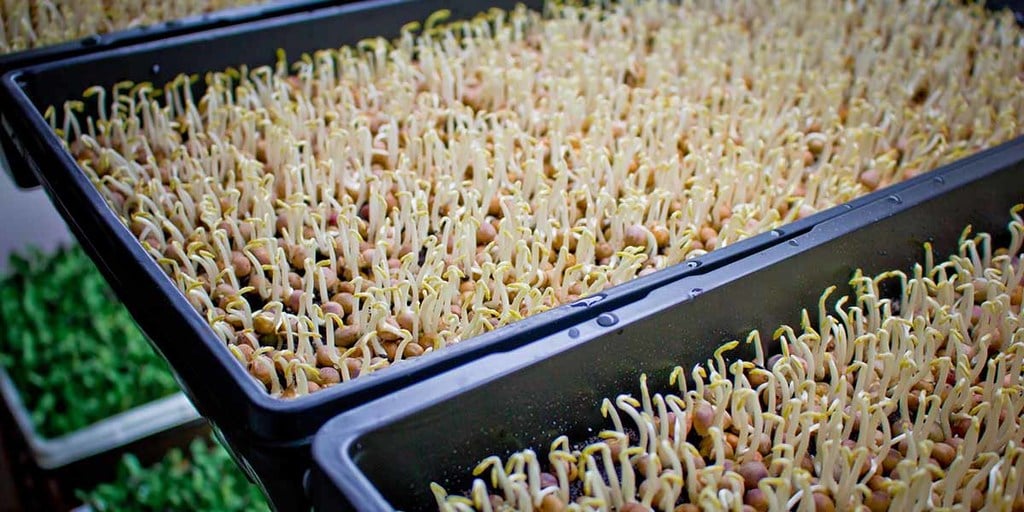
The microgreen growing process starts by soaking and sowing seeds on day 1. From day 1 to day 4, seeds will begin to germinate. Normally they remain covered and not exposed to light during this stage.
From day 5 to 12, the growing microgreens are uncovered and exposed to light, allowing them to start developing chlorophyll and nutrients. This is also the stage where they start to build up nutrition.
Depending on the type of seed you’re using, the harvest of your microgreens can vary. It might be as soon as day 12, or it could vary to up to 3 or 4 weeks.
The Parts of A Microgreen Growing Operation
These are the different areas you’ll need for your microgreen growing operation.
However, it’s worth noting that there is a lot more flexibility when it comes to growing microgreens, and some of these areas could be shared for multiple purposes.
-
A utility and preparation space. This is an area that you’ll use for weighing and soaking seeds, as well as germination.
-
A production space with shelving. This is where your microgreens will spend the majority of their lives as they’re growing. Shelving isn’t necessary if you’re just getting started. But for larger microgreens operations it’s a must-have to make maximum use of vertical space.
-
A wash and dry area. This can either be indoors or outdoors. You’ll need to wash your microgreens off in a gentle way without damaging them. Especially if you’re growing in compost. Then you’ll need a way to carefully dry them after washing.
-
A harvesting, packing, and storage space. After your microgreens are harvested, you’ll bring them to this area to pack them and prepare them for customers. Then you’ll want a walk-in cooler or some other way to store them and keep them fresh until they’re ready to be sold.
What Are The Similarities Between Mushrooms and Microgreens?
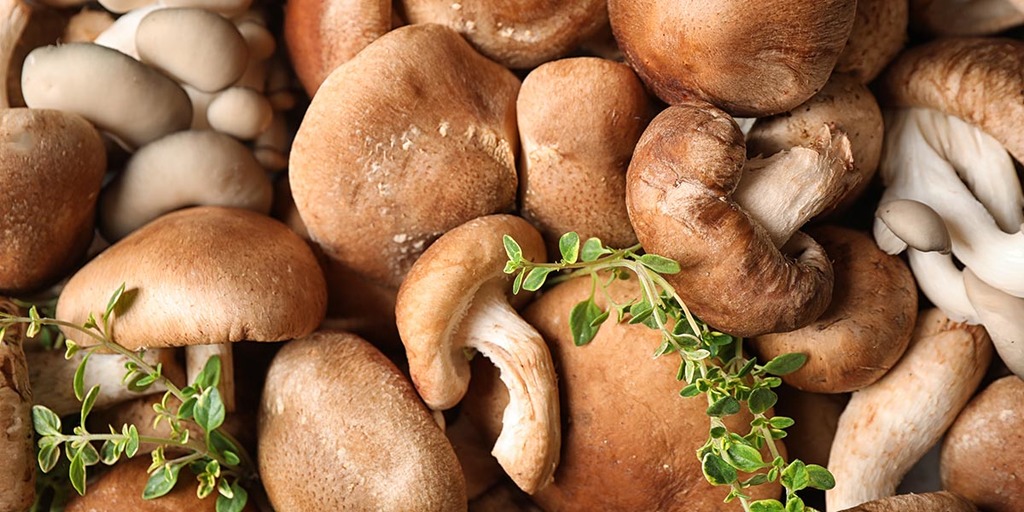
Growing both mushrooms and microgreens have a lot more in common than differences.
Both of these crops have got a quick growing cycle. You can make a new batch and harvest another batch every week to keep a continuous cycle going.
Both mushrooms and microgreens are grown indoors. That means you can grow either one in controlled environments all throughout the year.
This allows farmers to extend their growing season or supplement some of their more seasonal crops that can only be grown outdoors during the warmer months.
There are fairly simple ways of creating controlled environments that allow you to grow reliably all year round.
Neither one takes up a huge amount of space. A single room can produce thousands of dollars of either crop. And they can both make great use of vertical space.
They can also grow in unused indoor spaces that don’t necessarily have another use.
Years ago I grew in an unused portion of an office block in the middle of a city basement. I’ve seen similar grow operations in basements, railway tunnels, and even WWII air raid shelters.
Both mushrooms and microgreens yield high amounts of crops in small spaces.
The techniques and skills needed to grow either are absolutely manageable for newcomers. So don’t feel intimidated!
Growing mushrooms arguably takes a bit more care, particularly during the inoculation phase, but it’s nothing that the average person can’t pick up.
Best of all, both microgreens and mushrooms are highly desired crops that pretty much sell themselves!
In terms of nutritional value:
-
Mushrooms are high in: protein, iron, zinc, potassium, calcium, selenium. As well asB, C, & D vitamins.
-
Microgreens are high in: antioxidants, potassium, iron, zinc, magnesium, as well as vitamins A, C, & K.
-
Mushrooms are low in: calories, cholesterol, sodium, carbohydrates.
-
Microgreens are low in: calories, cholesterol, carbohydrates.
One of my favorite facts about microgreens is that they pack between 4 and 40 times the nutrients of their respective fully developed vegetables! Plus they contain polyphenols which attack free radicals in your body.
What Are The Differences Between Growing Mushrooms and Microgreens?
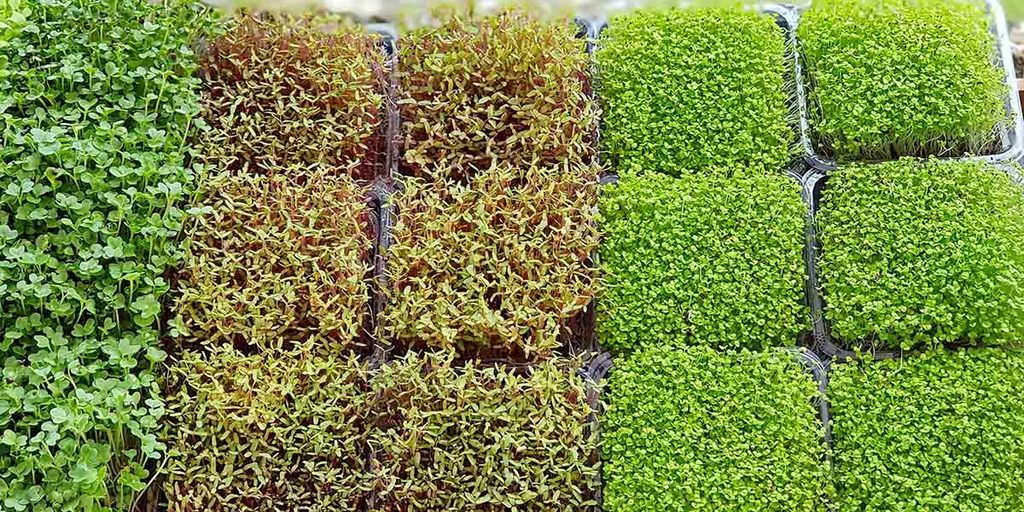
Even though growing either microgreens or mushrooms can be similar, there are some key differences to keep in mind too.
-
Number of crops per batch. With mushrooms, you get more than one crop per batch. After you harvest your first flush of mushrooms, another batch will be ready to harvest again within 1 or 2 more weeks. This isn’t the case with microgreens. Most varieties won’t grow back after you harvest them, and the whole tray has to be composted.
-
Light required. Microgreens require light to develop. Making sure they get enough light is a critical part of the growing process. Mushrooms don’t need to get energy from light. Although they are phototropic, meaning they will grow toward light, for most mushrooms they are not necessary. Although oyster mushrooms do need some light in order to form and shape correctly.
-
Crop cycle speed. Microgreens have a faster crop cycle than mushrooms. While mushrooms are already an incredibly fast crop at only 3 to 4 weeks to harvest, microgreens are even smaller, and can have a turnaround time as short as two weeks.
-
Separate space requirements. Mushrooms require very different conditions for incubation and fruiting, and you’ll need to have two distinctly different spaces for each. Microgreens don’t require a different space for different stages of their growing cycle, so you have a lot more flexibility about how you can lay out your operation.
Mushrooms vs. Microgreens: Output Comparison
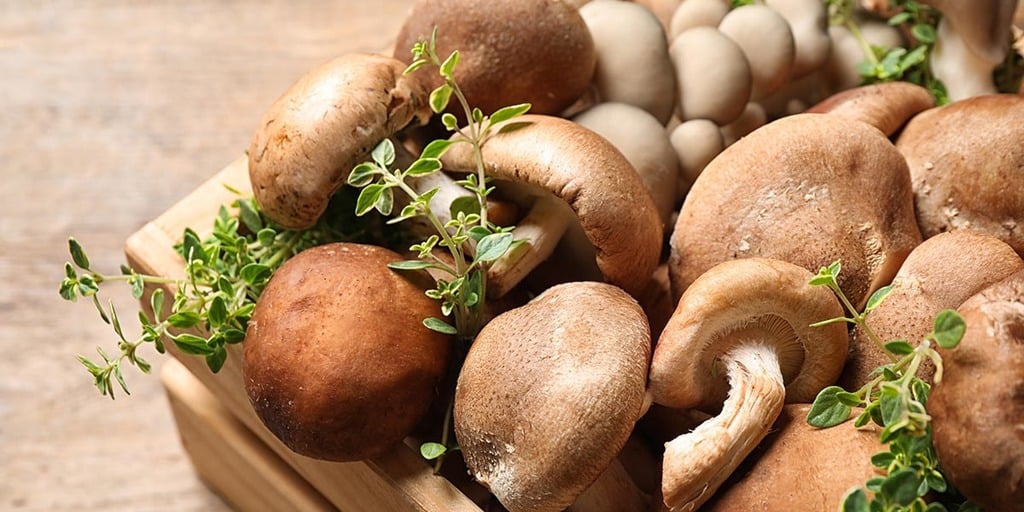
Let’s take a look at what kind of output you can expect if you’re comparing similar small scale production of mushrooms or microgreens.
Let’s assume either crop is growing in a room that’s 10m² (108 ft².)
For mushroom production, expect to put in about 10 hours of work to get back around 10 kg (22 lbs) of mushrooms grown. That’s about $220 worth of mushrooms if sold in the US, or £120 if sold in the UK at current prices.
For microgreens production, expect to put in about 8 hours of work and to get back about 8 kg (17.5 lbs) of microgreens. That’s about $525 worth of microgreens if sold in the US, or £200 if sold in the UK at current prices.
So we can see that microgreens are considerably more profitable, in terms of the amount of output you get compared to the space used and the amount of work put in.
Just bear in mind that it can be harder to sell large quantities of microgreens.
You don’t have to make a huge investment to start growing either microgreens or mushrooms.
You can start off with just one tray and some seeds in a windowsill in your kitchen for microgreens, or you can purchase a kit to start with mushrooms.
Once you start getting some income, you can reinvest the money to upgrade and get some supplies.
Why Grow Both Mushrooms and Microgreens Alongside Each Other?

If you’re already growing either mushrooms or microgreens, I think it makes a lot of sense to start growing the other as well. Here are a few reasons for that.
1. You Can Capitalize On Existing Routes To Market
If you’ve already got customers lined up for one product, it’s easier to add another product alongside it. You don’t need to go find new customers, you already have a customer base that knows you and trusts you.
The kind of customer who likes either is likely to be health-conscious and place value on fresh, locally grown food. So they will probably be interested in purchasing the other item as well.
So adding another product to your lineup makes a lot of sense. It’s just easier to get started and be in production.
2. The Daily Tasks Integrate Well Together
There’s a fair bit of crossover between growing mushrooms and microgreens. Namely, both require regular care and attention.
So if you’re already heading out to your farm to take care of one crop, it’s not that much extra work to take care of the other as well.
3. You Can Utilize Existing Infrastructure
It just takes a little bit of spare space to start producing some flats of microgreens in your mushroom growing operation, or vice versa.
It can be helpful in reducing your expenses to spread shared costs like overhead across two crops instead of one.
4. Take Advantage of Possible Synergies
There are areas where mushrooms and microgreens can work together.
For example, you can reuse the additional carbon dioxide produced from your mushroom operation to boost microgreens growth. During the incubation phase, mushrooms take in oxygen and put out carbon dioxide.
If you leave the incubation chamber with no ventilation, it quickly starts to fill with high levels of carbon dioxide. You can use ducts to vent the excess CO2 into your microgreens production room.
Plants use carbon dioxide to grow, so providing them with extra will help them to grow faster and also give them a nice boost to their overall health.
Just don’t vent air from your mushroom fruiting room into your microgreens. The reason is that the air in this space is too humid and contains lots of spores from the fruiting mushrooms.
You can run into too many issues with mold or contamination if you try to go this route, so only take CO2 from the incubation area.
On my own farm, I am looking into potentially using mushroom substrate as a compost for microgreens.
I’ve seen studies that suggest it’s possible, and I’m looking forward to trying this out for myself, although it’s still in the early stages.
This could potentially create a lot less input and expense in terms of soil.
Don’t Just Take Our Word For It!
Innovative farmers across the world are already combining microgreens and mushrooms with great success.
Take La Caverne for example. This company took an abandoned space right in the middle of Paris’ city center and recycled it into an urban farm.
Check out their website to learn more!
Frequently Asked Questions
Q: How much money can you make from growing mushrooms?
A: A growing area that’s around 200 square feet can produce around 800 pounds per crop. That’s about 5,000 pounds or $30,000 worth per year.
Q: Can I grow mushrooms from store bought mushrooms?
A: Yes, you can often find mycelium and primordia on store-bought oyster mushrooms that is fresh enough to start growing your own clones from. Although I’ve found it’s much easier and a much lesser risk of contamination to start with a culture or pre-inoculated growing medium instead.
Q: Do microgreens need to be washed?
A: Just like any other type of produce, you should wash microgreens before you eat them. Some people find this difficult to accomplish, but the easiest way is to lightly rinse them in cold water and then use a salad spinner to get them fully dry before you eat them.
Conclusion
Microgreens and mushrooms are both excellent crops for urban farmers. We expect to see more growers taking advantage of both of these crops together a lot more in the future.
Both crops are very similar in that they have quick crop cycles, can be grown indoors, and make excellent use of vertical space. Both are also packed full of nutrients.
However, there are some minor differences in terms of space and light required, the number of crops per batch, and other details.
